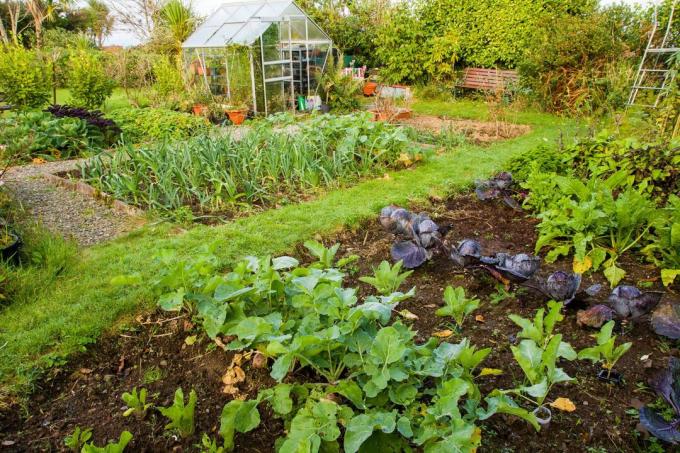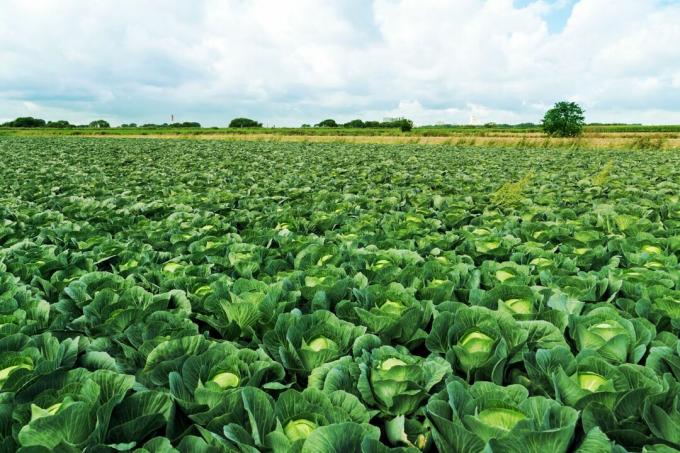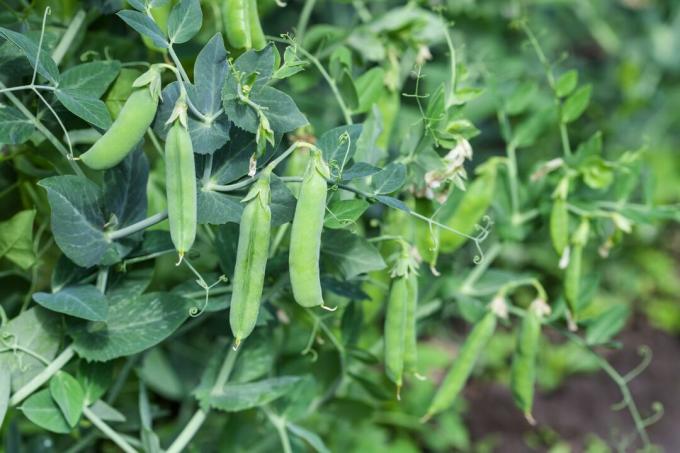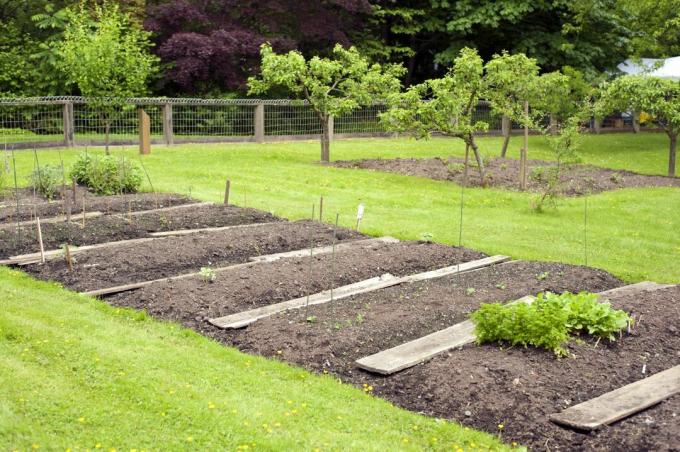Every spring the same question arises: Where do I put something in my vegetable garden? A planned crop rotation not only solves this problem, but also brings other advantages.

Crop rotation can be defined as the planned succession of different crops on a field or in a vegetable garden. But what is a sensible crop rotation in the vegetable garden, what do you have to pay attention to when planning your crop rotation in the garden and how do you start crop rotation? In this article, the principle of crop rotation is simply explained. You will also find a crop rotation table for vegetables and tips, for example for crop rotation with strawberries.
contents
- Crop rotation simply explained
- Advantages of crop rotation in the garden
- Vegetable garden crop rotation chart
Crop rotation simply explained
Farmers knew more than 1000 years ago that monocultures and the repeated cultivation of a Culture in a field leaches the soil and increases the incidence of diseases and pests to lead. They therefore developed the three-field economy. A winter crop was followed by a summer crop, after which the soil was allowed to rest for a year in the form of fallow land.

Of course, no grain is grown in the garden, but you can learn something from this old practice. A three-field or four-field system is also suitable for the garden.
First of all, you have to know that vegetables are divided into 3 classes:
- heavy feeder: They take a lot of nutrients from the soil. Therefore, beds for these cultures should be pre-fertilized with compost in autumn. In addition, they need regular fertilization during cultivation. Heavy consumers include, for example, all large ones cabbages (Brassica), cucumbers (Cucumis sativus), zucchini (Cucurbita pepo covar. giromontiina) and tomatoes (Solanum lycopersicum).
- Mean Eater: These require fewer nutrients than heavy feeders, so that preparing the bed with compost in autumn is sufficient for some of them. Belong to the middle eaters Kohlrabi (Brassica oleracea var. gongylodes L.), Beetroot (Beta vulgaris subsp. vulgaris), many salads and some umbellifers like carrots (Daucus carota subsp. sativus) and parsnip (Pastinaca sativa).
- weak feeder: They don't need a lot of nutrients and over-fertilization can even be harmful to some crops. legumes like beans (Phaseolus vulgaris) and Peas (Pisum sativum) lead to an accumulation of nitrogen in the soil thanks to a symbiosis with nitrogen-fixing bacteria.

Now you can divide your garden into 3 or 4 sections - one section each for the heavy, weak and medium consumers. If there is enough space in the garden, a fourth section should be added, in which a green manure grows. A field that was planted with heavy feeders in the first year is followed by medium feeders and then weak feeders the next year. A green manure gives the soil the necessary recovery before heavy feeders are grown again on this section next year. But even without this fourth step, it is possible to switch from weak consumers to heavy consumers. But then you have to use a little more compost and fertilizer.
These rules can be used to roughly divide up your garden. But of course you don't want to only grow 3 crops in your garden. In addition, for many types and families of vegetables, a cultivation break of 4 years or more should be observed. Therefore, one must further subdivide the 3 major sections. Cabbage, courgettes and cucumbers can be grown in the heavy feeder section. You just have to make sure that the beds are also rotated within the sections. This procedure is known as crop rotation and reduces the risk of disease from soil-borne pathogens Clubroot (Plasmodiophora brassicae) or the late blight (Phytophthora infestans). In addition, you prevent a drop in yield for self-incompatible species such as peas in particular.
Tip: In many gardens there is also space for permanent crops. These include strawberries (Fragaria) staying in one place for 3 years, as well as rhubarb (Rheum rhabarbarum) and asparagus (Asparagus officinalis) that occupy a place for even 8 to 10 years. In the crop rotation, for example, strawberries can first be placed in the bed of the heavy feeder. With a four-field economy, they can simply move back to the heavy-consumer field after the 3 years. In this way, the required cultivation break of at least 3 years is observed for strawberries.

Finally, one should deal with secondary and mixed cultures. Tomatoes, for example, do not occupy a bed all year round. They are not planted outdoors or in a greenhouse until mid-May. So there's still plenty of time before that, for example radish (Raphanus sativus var. sativus) or salad to plant. When the tomatoes are cleared from the bed, there is still time for spinach (Spinacia oleracea) or a winter salad.
In intercropping, plants that get along well or even support each other are grown close together. As a typical example here are often onions (Allium cepa) and carrots because they scare each other off certain pests. Similar is at celery (Apium graveolens) and cabbage possible.

Tip: In order to meet the nutrient requirements of the individual crops, more targeted fertilization is required when growing secondary and main crops. For example, fertilizer can only be applied when the heavily consuming main crop is planted. However, you should then use a fertilizer that makes nutrients available more quickly, which is usually not the case with compost. Instead, for example, our Plantura Organic Tomato & Vegetable Fertilizer be deployed. It has a high level of direct nitrogen availability, yet consists of 100% natural ingredients and contributes to healthy soil life with effective microorganisms.

Plantura Organic Tomato & Vegetable Fertilizer
Highly effective organic liquid fertilizer
with an NK ratio of 4-5
for all types of vegetables & berries,
safe for pets and garden animals
Advantages of crop rotation in the garden
Even the farmers in the early Middle Ages recognized the advantages of three-field farming. With the findings of the last few decades, even more positive effects can be achieved with crop rotation in the garden.
- Higher yields and yield stability: The single culture brings higher yields if it is not always grown on the same bed. The failure of a crop also has less of an impact on the total yield, as many different crops are grown.
- Optimal nutrient utilization: Each culture gets the nutrient supply that is suitable for it. In addition, the constant change does not unilaterally remove nutrients from the soil.
- Less diseases: Pathogens or pests often survive in the soil - sometimes they can even survive there for several years. If the same culture is always grown on a bed, this can lead to massive propagation and total failure of the culture.
- Weeds are kept at bay: Different cultures ensure a varying coverage and root penetration of the soil. For example, a cabbage that is still standing in autumn suppresses the germination of weed species that prefer to germinate in autumn.
- Soil fertility is preserved: Soil life and nutrients are stressed differently. The cultivation of legumes even leads to nutrient input and the soil can recover under green manure.

Vegetable garden crop rotation chart
Below is a vegetable crop rotation chart to help you plan your crop rotation. You should note that the cultivation breaks apply to all plants in a family. In the crop rotation should after potatoes (Solanum tuberosum) so in the next 4 years neither tomatoes nor paprika (capsicum) or eggplants (Solanum melongena) are grown.
Don't forget: There is no perfect crop rotation. You always have to make compromises somewhere and you will never keep all grow breaks. Don't let that discourage you though, just get started. In general, the more diverse and colorful your garden is, the better.
| plant family | kind | nutrient requirements* | cultivation break | particularities |
|---|---|---|---|---|
| Cruciferous (Brassicaceae) | Cauliflower, broccoli, white cabbage, red cabbage, savoy cabbage, pointed cabbage Kohlrabi, Chinese cabbage radish |
heavy feeder medium eater weak feeder |
5-6 years | Do not use mustard as a cover crop before cabbage varieties. It belongs to the same plant family and is therefore also a disease vector. With their short cultivation time, kohlrabi and Chinese cabbage are well suited as pre- and post-culture for tomatoes, peppers and cucumbers, for example. Radishes are ideal gap fillers. |
| umbellifers (Apiaceae) |
celery Parsnip, fennel, carrot Parsely |
heavy feeder medium eater weak feeder |
3 – 4 years | Celery is often grown with cabbage. Medium feeders such as beetroot are ideal as a follow-up crop next year. Fennel doesn't mix well with tomato and dill. Carrots and onions form a suitable mixed culture. Legumes or heavy feeders can be grown after parsley. |
| legumes (Fabaceae) |
French beans, runner beans, peas, chickpeas | weak feeder | 5-6 years | In a three-field economy, legumes are the ideal third crop. After beans, peas and the like, the crop rotation starts all over again. |
| onion plants (Allioideae) |
Leek Onion garlic |
heavy feeder weak feeder weak feeder |
5 years | After leeks, which stand until spring, carrots can easily be grown. Onions are followed by green manure in the crop rotation or the cycle is started again. Garlic has a preventive effect against mice, snails and fungal diseases and is therefore a good mixed culture partner for many crops. |
| nightshade family (Solanaceae) |
eggplant, peppers, tomato Potato |
heavy feeder heavy feeder |
4 years | In the crop rotation after tomatoes, for example, corn is a good choice. With potatoes in crop rotation, diseases and pests are actually inevitable. With long breaks in cultivation, however, the severity of the infestation can be reduced. |
| Pumpkin family (Cucurbitaceae) | Cucumber, zucchini, pumpkin, melon | heavy feeder | 3 – 4 years | In the crop rotation, cucumber, zucchini and pumpkin should not follow each other. Suitable subsequent crops are, for example, corn and beetroot. |
| daisy family (Asteraceae) | Lettuce, black salsify, sugar loaf, chicory | medium eater | 3 years | Lettuce is often used as a gap filler and the cultivation break is therefore not observed. In most cases, however, this is fine. |
| Goosefoot family (Amaranthaceae) | Spinach, beetroot, chard | medium eater | 3 years | In the next year, beetroot is followed by weak consumers such as carrots and onions or legumes. Spinach in crop rotation is flexible thanks to its short growing season. |
| Sweet grasses (Poaceae) Valerian family (Valerianoideae) |
Corn Lamb's lettuce |
medium eater weak feeder |
3 years 4 years |
After corn, you have a wide choice in crop rotation. Onions or beans are possible, for example. After lamb's lettuce, any other plant family can be grown. |
*The division into heavy, weak and medium consumers is not always clear. There are no clear boundaries in nature. For example, onions are considered by some to be moderate consumers and others to be weak consumers.
crop rotation and mixed culture in vegetables bring many benefits. You can read about exactly what the mixed culture is all about and which plants go together in an extra article.
...and receive concentrated plant knowledge and inspiration directly in your e-mail inbox every Sunday!



